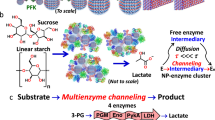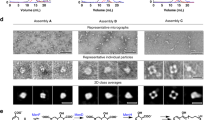Abstract
A detailed protocol for the large-scale synthesis of carbohydrate and dihydrolipoic acid (DHLA)-coated CdSe/ZnS and CdTe/ZnS nanoparticles using continuous flow reactors is described here. Three continuous flow microreaction systems, operating at three different temperatures, are used for the synthesis of mannose-, galactose- or DHLA-functionalized quantum dots (QDs). In the first step of synthesis, the CdSe and CdTe nanoparticles are prepared. The size and spectral properties of the CdSe core of the nanoparticles are controlled by adjustment of the residence time and the temperature. As a second step, the zinc sulfide capping under homogenous conditions is carried out at a substantially lower temperature than is required for nanoparticle growth in batch processes. Finally, the trioctylphosphine/oleic acid ligand is effectively replaced with either carbohydrate PEG-thiol moieties or DHLA at 60 °C. This new protocol allows the synthesis of biologically active fluorescent QDs in 4 d.
This is a preview of subscription content, access via your institution
Access options
Subscribe to this journal
Receive 12 print issues and online access
$259.00 per year
only $21.58 per issue
Buy this article
- Purchase on Springer Link
- Instant access to full article PDF
Prices may be subject to local taxes which are calculated during checkout









Similar content being viewed by others
References
Deka, S. et al. CdSe/CdS/ZnS double shell nanorods with high photoluminescence efficiency and their exploitation as biolabeling probes. J. Am. Chem. Soc. 131, 2948–2958 (2009).
Weiss, E.A. et al. Size-dependent charge collection in junctions containing single-size and multi-size array of colloidal CdSe quantum dots. J. Am. Chem. Soc. 130, 74–82 (2008).
Weiss, E.A. et al. The use of size-selective excitation to study photocurrent through junctions containing single-size and multi-size arrays of colloidal CdSe quantum dots. J. Am. Chem. Soc. 130, 83–92 (2008).
Xie, R., Kolb, U., Li, J., Basch, T. & Mews, A. Synthesis and characterization of highly luminescent CdSe-Core CdS/ZnCdS/ZnS multishell nanocrystals. J. Am. Chem. Soc. 127, 7480–7488 (2005).
Mattoussi, H. et al. Self assembly of CdSe-ZnS quantum dot bioconjugates using an engineered recombinant protein. J. Am. Chem. Soc. 122, 12142–12150 (2000).
Babu, P., Sinha, S. & Surolia, A. Sugar-quantum dot conjugates for a selective and sensitive detection of lectins. Bioconjugate Chem. 18, 146–151 (2007).
Sun, X.L. et al. Chem. Bio. Chem. 5, 1593–1596 (2004).
Kim, J. et al. In vivo real-time bioimaging of hyaluronic acid derivatives using quantum dots. Biopolymers 89, 1144–1153 (2008).
Robinson, A. et al. Probing lectin and sperm with carbohydrate-modified quantum dots. ChemBioChem 6, 1899–1905 (2005).
Niikura, K. et al. Oligosaccharide-mediated nuclear transport of nanoparticles. ChemBioChem 9, 2623–2627 (2008).
Higuchi, Y. et al. Mannosylated semiconductor quantum dots for labeling of macrophages. J. Control. Release 125, 131–136 (2008).
Jiang, X. et al. Biotinylated glycol-functionalized quantum dots: synthesis, characterization, and cytotoxicity studies. Bioconjugate Chem. 20, 994–1001 (2009).
Chan, W.C. & Nie, S. Quantum dots bioconjugates for ultrasensitive nonisotopic detection. Science 281, 2016–2018 (1998).
Bruchez, M., Moronne, M., Gin, P., Weiss, S. & Alivisatos, A.P. Semiconductor nanocrystal as fluorescent biological labels. Science 281, 2013–2016 (1998).
Howarth, M. et al. Targeting quantum dots to surface proteins in living cells with biotin ligase. PNAS 102, 7583–7588 (2005).
Kim, S., Fisher, B., Eisler, H.J. & Bawendi, M. Type-II quantum dots: CdTe/CdSe(Core/Shell) and CdSe/ZnTe(Core/Shell) heterostructures. J. Am. Chem. Soc. 125, 11466–11467 (2003).
Giepmans, B.N.G., Adams, S.R., Ellisman, M.H. & Tsien, R.Y. The fluorescent toolbox for assessing protein location and function. Science 312, 217–224 (2006).
George, N., Pick, H., Vogel, H., Johnsson, N. & Johnsson, K. Specific labeling of cell surface proteins with chemically diverse compounds. J. Am. Chem. Soc. 126, 8896–8897 (2004).
Stroh, M. et al. Quantum dots spectrally distinguish multiple species within the tumor milieu in vivo. Nat. Med. 11, 678–682 (2005).
Somers, R.C., Bawendi, M.G. & Nocera, D.G. CdSe nanocrystal based chem.-/bio- sensors. Chem. Soc. Rev. 36, 579–591 (2007).
Liu, W. et al. Compact Cystein-coated CdSe(ZnCdS) quantum dots for in vivo applications. J. Am. Chem. Soc. 129, 14530–14531 (2007).
Murray, C.B., Norris, D.J. & Bawendi, M.G. Synthesis and characterization of nearly monodisperse CdE (E = sulfur, selenium, tellurium) semiconductor nanocrystallites. J. Am. Chem. Soc. 115, 8706–8715 (1993).
Qu, L., Peng, Z.A. & Peng, X. Alternative routes toward high quality CdSe nanocrystals. Nano Lett. 1, 333–337 (2001).
Li, J.J. et al. Large-scale synthesis of nearly monodisperse CdSe/CdS Core/Shell nanocrystals using air-stable reagents via successive ion layer adsorption and reaction. J. Am. Chem. Soc. 125, 12567–12575 (2003).
Ehrfeld, W. et al. Microreactors: New Technology for Modern Chemistry. (Wiley-VCH, 2000).
Hessel, V. et al. Chemical Micro Process Engineering (Wiley-VCH, 2004).
Wiles, C. & Watts, P. Continuous flow reactor, a tool for the modern synthetic chemist. Eur. J. Org. Chem. 1655–1671 (2008).
Mason, B.P. et al. Greener approaches to organic synthesis using Microreactor technology. Chem. Rev. 107, 2300–2318 (2007).
Geyer, K., Codée, J.D.C. & Seeberger, P.H. Microreactor as tools for synthetic chemists – the chemists' round-bottomed flask of the 21st century? Chem. Eur. J. 12, 8434–8442 (2006).
Marre, S. et al. Supercritical continuous-microflow synthesis of narrow size distribution quantum dots. Adv. Mater. 20, 4830–4834 (2008).
Yen, B.K.H., Günther, A., Schmidt, M.A., Jensen, K.F. & Bawendi, M.G. A microfabricated gas-liquid segmented flow reactor for high-temperature synthesis: the case of CdSe quantum dots. Angew. Chem. Int. Ed. 44, 5447–5451 (2005).
de la Fuente, J.M. & Penadés, S. Glyco-quantum dots: a new luminescent system with multivalent carbohydrate display. Tetrahedron: Asymmetry 16, 387–391 (2005).
Aaron, R.C. et al. Quantum dot-based multiplexed fluorescence resonance energy transfer. J. Am. Chem. Soc. 127, 18212–18221 (2005).
Susumu, K., Mei, B.C. & Mattoussi, H. Multifunctional ligands based on dihydrolipoic acid and polyethylene glycol to promote biocompatibility of quantum dots. Nat. Protoc. 4, 424–436 (2009).
Susumu, K. et al. Enhancing the stability and biological functionalities of quantum dots via compact multifunctional ligands. J. Am. Chem. Soc. 129, 13987–13996 (2007).
Liu, W. et al. Compact biocompatible quantum dots functionalized for cellular imaging. J. Am. Chem. Soc. 130, 1274–1284 (2008).
Carrillo-Carrion, C., Cordenas, S., Simonet, B.M. & Valcarcel, M. Selective quantification of carnitine enantiomers using chiral cysteine-capped CdSe(ZnS) quantum dots. Anal. Chem. 81, 4730–4733 (2009).
Kikkeri, R., Laurino, P., Odedra, A. & Seeberger, P.H. Synthesis of carbohydrate-functionalized QDs in Microreactors. Angew. Chem. Int. Ed. 49, 2054–2057 (2010).
Leutherdale, C.A., Woo, W.-K., Mikulec, F.V. & Bawendi, M.G. On the absorption cross section of CdSe nanocrystal quantum dots. J. Phys. Chem. 106, 7619–7622 (2002).
Weis, W.I. & Drickamer, K. Structural basis of lectin-carbohydrate recognition. Annu. Rev. Biochem. 65, 441–473 (1996).
Acknowledgements
Generous funding from the Max Planck Society is gratefully acknowledged.
Author information
Authors and Affiliations
Contributions
P.L. and R.K. carried out the experiments and designed the protocol. P.H.S. designed and supervised the project. P.L., R.K. and P.H.S. wrote the manuscript.
Corresponding author
Rights and permissions
About this article
Cite this article
Laurino, P., Kikkeri, R. & Seeberger, P. Continuous-flow reactor–based synthesis of carbohydrate and dihydrolipoic acid–capped quantum dots. Nat Protoc 6, 1209–1220 (2011). https://doi.org/10.1038/nprot.2011.357
Published:
Issue Date:
DOI: https://doi.org/10.1038/nprot.2011.357
This article is cited by
-
Glyconanomaterials: Emerging applications in biomedical research
Nano Research (2014)
Comments
By submitting a comment you agree to abide by our Terms and Community Guidelines. If you find something abusive or that does not comply with our terms or guidelines please flag it as inappropriate.



